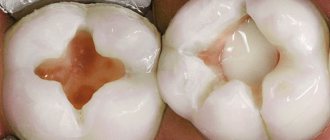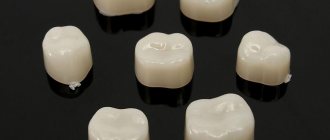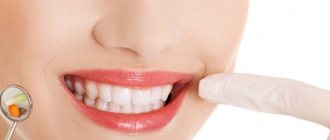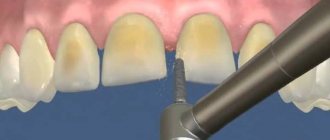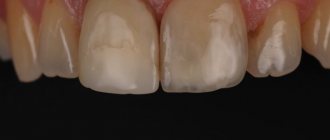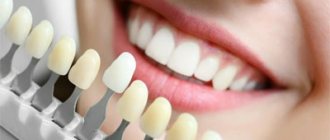A. I. Nikolaev, L. M. Tsepov Practical therapeutic dentistry
St. Petersburg: St. Petersburg Institute of Dentistry and, 2001. - 390 p. ISBN 5-94517-001-1
The book covers at a modern level the issues of etiology and pathogenesis of one of the most common human diseases - dental caries. Its treatment using modern methods of pain relief, premedication, and psychological preparation of patients is described in detail. The characteristics of filling materials used at dental appointments are given. Medications used in endodontics are described.
Modern methods of endodontic treatment are outlined, including a description of the endodontic instrumentation used, methods of instrumentation and root canal filling, as well as ways to improve the quality of endodontic treatment.
A separate section is devoted to the etiology, pathogenesis, clinical and morphological characteristics of chronic inflammatory periodontal diseases, and also presents the basic principles of complex therapy of chronic general and gaping periodontitis in an outpatient dental appointment. The final section provides the methodological basis for organizing periodontal care. All this gives reason to believe that the book will be useful to both an experienced dentist and a novice doctor.
The book is intended for students, interns, residents, dentists, teachers of dental faculties of medical universities, and persons studying in the system of postgraduate professional education.
Reviewers:
L. N. Maksimovskaya - Doctor of Medical Sciences, Professor, Head. Department of General Dentistry, Faculty of Advanced Training for Doctors, Moscow State Medical and Dental University, President of the Russian Academy of Aesthetic Dentistry.
V. B. Nsdossko - Doctor of Medical Sciences, Professor, Head of the Department of Therapeutic Dentistry of the Omsk State Medical Academy.
Preface.
Medical Internet conferences
Purpose: Selecting the most suitable method for preparing hard dental tissues for permanent restorations in clinical practice.
Objectives: 1) Familiarize yourself with the goals and principles of preparation.
2) Consider methods for preparing tooth surfaces.
3) Consider methods for forming a ledge.
4) Compare preparation methods to determine which is most suitable for use in clinical practice.
1.Purposes of preparation:
Purpose: Selecting the most suitable method for preparing hard dental tissues for permanent restorations in clinical practice.
Objectives: 1) Familiarize yourself with the goals and principles of preparation.
2) Consider methods for preparing tooth surfaces.
3) Consider methods for forming a ledge.
4) Compare preparation methods to determine which is most suitable for use in clinical practice.
1.Purposes of preparation:
1) Preparation of all necrotic and damaged tooth tissues.
2) Maximum preservation of healthy tissues
3) Creation of conditions for retention of a fixed structure
4) Providing functional occlusion
5) Minimizing injuries to the oral mucosa.
Principles:
Preservation of hard tissues. Preparation of a tooth for a crown is accompanied by reduction of a sufficient amount of hard tooth tissue in order to provide space for a sufficient amount of restoration material, especially on the occlusal surface, where tissue reduction can reach 1.5 mm; it is necessary to bevel the functional tubercle (palatal in the upper jaw and buccal in the lower jaw) . It is important to preserve the anatomical shape of the prepared tooth and its group affiliation.
Retention of the restoration is ensured mainly by the shape of the tooth stump, such as: stump height (must be at least 2/3 of the initial crown height), stump area and taper.
The taper of the stump should be on average 6-10*, mainly for the anterior group of teeth. Retention reaches its maximum strength at a taper of 3*. As for the stability of the restoration, the following pattern can be identified: the greater the height of the stump and the smaller the radius, the more stable the restoration will be.
Tooth preparation has a number of contraindications:
1) General: previous myocardial infarction, hypertension, allergies to anesthetics, mental illness, etc.
2) Local contraindications are associated with the possibility of preserving vital dental pulp and are a reason for devitalization.
Preparation principles:
1) Biological aspect - maximum preservation of tooth tissue, elimination of excessive grinding, creation of a supragingival ledge and harmonious occlusion.
2) Aesthetic aspect – to achieve minimal visualization of the metal and maximum thickness of the ceramic coating.
3) Mechanical aspect - creating reliable fixation, stability, eliminating the possibility of deformation of the structure.
2. Preparation methods consist of separate stages, with the help of which in clinical practice the doctor maintains the biological width of the tooth and creates an adequate prosthetic space for restoration.
1) Oblique preparation method according to Martignoni and Schonenberg.
The method involves programming the depth of preparation of the hard tissues of the tooth by means of a saw cut beveled at an angle of 45* to the vertical axis along the cutting/chewing surface; later, the ledge is marked at the same angle, followed by excision of the remaining surfaces.
Pros:
— control of the depth of preparation in the cervical area.
— creation of sufficient occlusal space due to the formation of a beveled surface.
Minuses:
— The line of the ledge on the plaster model can only be determined with sufficient magnification.
— The method requires high manual skills of the doctor and great concentration during preparation.
2) Two-plane preparation method according to Kuwata based on the theory of three planes of the tooth.
The essence of the method is to prepare tissues while maintaining the inclination of the natural planes of the tooth and creating a ledge of 50° to the long axis of the tooth.
Pros:
— Manipulation does not require high manual skills.
— Rational direction of preparation, taking into account the individual topographical characteristics of the tooth.
— Preventive “protection” of the pulp of vital teeth.
Minuses:
— inability to control the depth of preparation.
— Relative consideration of tooth safety zones in terms of its position in the dentition.
3) Method of guiding grooves according to Stein.
The method is based on applying furrows of a certain depth to the prepared surfaces through the use of various calibration burs and further preparing the surfaces to a given depth.
Pros:
— Controlled preparation depth.
— the ability to more accurately take into account safety zones and individual topographical features of teeth.
Minuses:
— The need for accurate calibration of burs and its evaluation with a special measuring tool.
— The position of the tooth in the dentition is not taken into account.
— The impossibility of adequately assessing the depth of reduction of the tooth surface in case of dentition deformations.
4) Gürel's method.
The method is based on the preliminary fixation of a temporary composite restoration on non-prepared teeth, made on the basis of wax modeling. Without removing the composite restoration, we mark the depth of the preparation and then form the core.
Pros:
— Preparation is carried out taking into account the individual characteristics of the tooth.
— Visualization of the thickness of the surface preparation, taking into account the position of the tooth in the dentition.
— Minimization of tooth reduction during preparation.
Minuses:
— Requires additional time and economic costs, equipment and materials.
— Limited use, mainly when using adhesive indirect restorations.
— the difficulty of using the method in the distal parts of the jaw and with pronounced vestibular inclination of the teeth.
5) Method of preparation by tooth segments according to McLean.
The essence of the method is to divide the tooth into segments, the number of which depends on the functional surface of the tooth. First, one half is prepared from the vestibular, oral and occlusal surfaces. Later the second half. Subsequently, the cervical border is formed and finishing is performed.
Pros:
- Ease of manipulation.
— visualization of the thickness of the preparation.
— preparation taking into account the individual topographical characteristics of the tooth.
Minuses:
— relative control of the volume of preparation.
- difficulty of preparation in case of deformation of the dentition.
6) Two-stage preparation according to Massironi.
The essence of this method assumes that at the first stage the tooth is prepared for a certain structure with the location of the border of the closing line above the gum level and the subsequent fixation of provisional crowns. At the second stage, gum retraction is carried out with the final formation of a circular ledge and finishing of the tooth.
Pros:
— Controlled preparation taking into account individual topographic features.
— Protection of the epithelial attachment of the tooth.
Minuses:
— The need for a high level of manual skills, materials, tools, as well as time.
— Difficulty taking into account the peculiarities of the morphometric parameters of the biological zone of the teeth when forming a circular ledge.
3. Formation of a ledge is the most difficult stage in the preparation process, both its localization and choice of shape. The shape of the ledge determines: the amount of restoration material, marginal fit, the possibility of correction and constant care for it.
Principles of ledge formation:
Only with the correct connection and adaptation of the boundaries of the ledge and the orthopedic structure is its durability, functionality and aesthetics possible.
The ledge options are determined by the choice of design:
1) The groove-shaped ledge is used for MC and ceramics.
2) Ledge 120-135* for MK.
3) Shoulder shoulder 90* with an internal right angle for MK and ceramics.
4) Shoulder shoulder 90* with rounded internal corner for ceramics.
Also, the ledge is selected depending on the periodontium and hard tissues of the tooth.
There are two types of ledge arrangement:
1) Subgingival. Indications are aesthetic requirements, carious lesions and hyperesthesia in the area of the necks of teeth, low crown part, subgingival tooth fracture, repeated prosthetics.
2) Supragingival and at the level with the gingival margin. They are used in cases of low lip line, absence of visual necks of teeth in the smile, likelihood of complications from periodontal tissues, high clinical crown, generalized periodontitis of moderate severity, absence of previous sublingual preparation.
In order to minimize complications from periodontal tissues, the preparation of the ledge requires compliance with the biological width.
Biological width is a complex of tissues located above the alveolar ridge, including connective tissue and tooth-attached epithelium, which fill the space between the bottom of the sulcus and the alveolar ridge.
The edge of the subgingival preparation should end in the area of the middle of the periodontal sulcus.
The formation of the final ledge is carried out after installing the retraction thread with an increasing tip at low speeds.
Conclusion: Having considered all the above preparation methods, we can draw the following conclusion: due to the variety of clinical cases, indications and contraindications, it is impossible to choose one best preparation method. You should also take into account the huge variety of materials, manufacturing technologies for fixed dentures and the different technical capabilities of medical institutions. Based on this, in practice it is permissible to use any of the above methods, which is most convenient for the attending physician to use and allows one to obtain the most positive result for the patient’s health.
